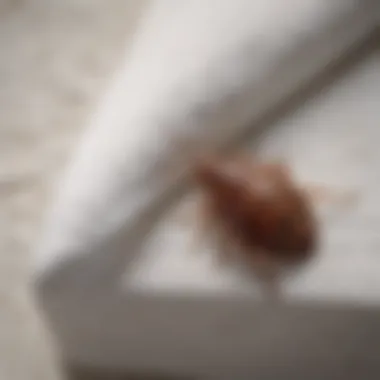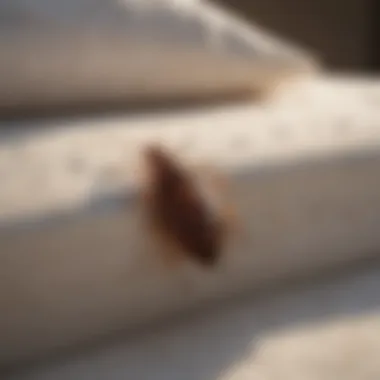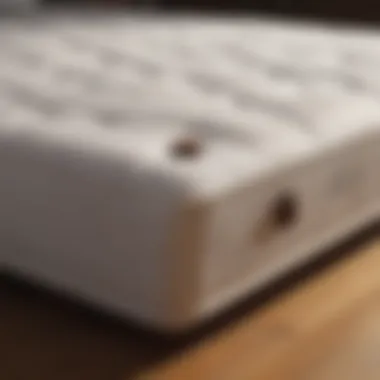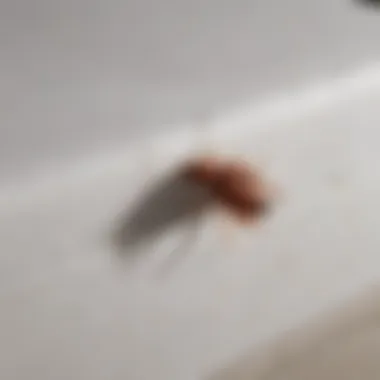Essential Bed Bug Proof Covers for Twin XL Mattresses


Intro
Bed bugs are notorious for their ability to infest homes and disrupt lives. Twin XL beds, often used in dormitories and guest rooms, can be particularly vulnerable to these pests due to their compact size and the frequency of use. Understanding the nature of bed bugs and how to effectively combat them is crucial for homeowners and housewives alike. One key element in this battle is the utilization of bed bug proof mattress covers. These covers serve as both a barrier against bed bugs and a protective layer for the mattress itself.
This article aims to provide a well-rounded guide on selecting the right mattress cover for twin XL beds, detailing various features, benefits, and essential criteria for making an informed choice. Additionally, the guide will explore several types of protective covers, installation tips, and maintenance recommendations while addressing the role these covers play in integrated pest management. Environmental considerations regarding the materials used in bed bug mattress covers will also be examined to cater to the growing interest in sustainable solutions. The following sections will delve into critical aspects surrounding bed bug identification, prevention methods, and effective do-it-yourself solutions.
By equipping yourself with the right knowledge, you will not only safeguard your home but also ensure a healthier living environment.
Understanding Bed Bugs and Their Impact
Bed bugs are small, parasitic insects that feed on the blood of humans and animals. Their presence can lead to significant discomfort and health risks, making understanding them crucial for effective pest management. An awareness of bed bugs, including their biology and behavior, is essential before investing in mattress covers specifically designed to protect against these pests. This background helps homeowners make informed decisions about prevention and treatment.
Biology and Behavior of Bed Bugs
Bed bugs, scientifically known as Cimex lectularius, are nocturnal creatures that prefer dark and secluded spaces. They typically hide in cracks and crevices during the day. They can easily enter homes through various means, including luggage, clothing, or second-hand furniture. Recognizing their habits helps in the early detection of an infestation.
Bed bugs undergo a life cycle that includes eggs, nymphs, and adults. Females can lay up to five eggs per day and over 500 in their lifetime. These eggs are tiny and nearly imperceptible to the naked eye, making it easy for infestations to grow unnoticed. In terms of behavior, bed bugs are attracted to warmth and carbon dioxide, which helps them identify their hosts for feeding. They feed on blood by injecting saliva that contains anticoagulants to facilitate feeding. This behavior can lead not only to irritation but can also contribute to anxiety and stress in affected individuals.
Health Implications of Bed Bug Infestations
Bed bug infestations can have serious health implications beyond skin irritation. While they are not known to transmit disease, their bites can lead to secondary infections due to scratching. The reactions to bed bug bites vary among individuals; some may experience only mild redness or itchiness, while others may develop severe allergic reactions requiring medical attention. Additionally, the psychological impact of an infestation can be profound.
People often report feelings of embarrassment, anxiety, and insomnia due to the fear of being bitten. The stigma associated with bed bugs can lead to social withdrawal and decreased quality of life. Thus, maintaining knowledge about these pests and recognizing their presence is essential for both physical and mental well-being.
"Awareness of bed bugs and the implications of infestations is the first step in empowerment to prevent and manage them effectively."
The Importance of Mattress Protection
Protecting your mattress from bed bugs is essential for many reasons. Not only do bed bugs disrupt sleep, but they can also cause distress and health issues. Investing in bed bug proof mattress covers is a practical solution to safeguard against infestations. These covers act as a barrier, preventing bed bugs from accessing the mattress, which is one of their favorite hiding spots.
The use of mattress protection also plays an important role in maintaining hygiene in your sleeping environment. Once bed bugs invade, they can be challenging to eliminate. A bed bug proof cover simplifies pest control efforts by containing any potential infestation. This proactive measure protects not just your mattress but also extends to bedding, pillows, and other surfaces in contact.
Furthermore, mattress covers enhance the lifespan of the mattress itself. The materials used in these covers often repel moisture and spills. This means that allergens and mold are less likely to permeate the mattress, ensuring a fresher and cleaner sleeping environment. Regular cleaning and the right protective cover can prevent the accumulation of dust mites and other allergens which can exacerbate existing health conditions.
Role of Mattress Covers in Pest Prevention
Bed bug proof mattress covers are an effective line of defense. They create an impermeable barrier that blocks bed bugs from getting in or out. These covers are designed with zippers and special seals that prevent bed bugs from sneaking through seams or openings. When using these covers, it is important to ensure that the cover fits snugly around the mattress and is securely zipped. Loose-fitting covers can leave gaps that offer entry points.
In addition to the physical barrier, the qualities of the material also play a role in pest prevention. Many covers are made from durable, densely woven fabrics that bed bugs are unable to penetrate. This ensures that if any bed bugs are already residing within the mattress, they cannot escape, allowing for easier management of potential infestations. Regular inspections of the mattress cover can further alert you to any issues.
How Bed Bug Covers Compliment Integrated Pest Management
Bed bug proof mattress covers are not a standalone solution; they work best within an integrated pest management (IPM) strategy. IPM combines various approaches to prevent and control pests. The mattress cover serves as one key component among others, such as regular cleaning, vacuuming, and, when necessary, professional pest control services.
Using mattress covers complements other IPM techniques by minimizing the chances of an infestation spreading throughout the home. For those who travel or stay in infested places, having a bed bug proof cover means that they can easily protect their mattress back home. This preemptive approach is vital for anyone concerned about the risks bed bugs pose. Moreover, educating yourself on other strategies within IPM creates a more well-rounded defense plan.
A bed bug proof cover not only protects the mattress but also contributes significantly to an overall pest management strategy, enhancing the effectiveness of all prevention efforts.
Characteristics of a Good Bed Bug Proof Mattress Cover
A bed bug proof mattress cover is an essential line of defense against bed bug infestations. Understanding the characteristics that define a high-quality mattress cover can empower homeowners to make informed choices. The right cover not only protects from pests but also contributes to overall sleep health and comfort. Here, we will explore the vital elements that ensure a bed bug proof mattress cover is effective and reliable.


Material Composition
Material composition plays a crucial role in determining both the effectiveness and comfort of a bed bug proof mattress cover.
Types of fabrics used
Different types of fabrics can be employed in the construction of bed bug mattress covers. Polyester and tightly woven cotton are commonly used because they provide a robust barrier against pests. The tight weave prevents bed bugs from penetrating the cover, making it a practical choice. Additionally, fabrics like lycra stretch for snug fit, ensuring that there are no gaps. This aspect is particularly important for preventing any possible exposure to pests.
Key Characteristics:
- Durability: Tightly woven fabrics withstand wear and tear better.
- Barrier Quality: Fabrics provide effective protection against bed bugs and allergens.
Unique Feature: The waterproof option is available, which adds another layer of protection and makes cleaning easier. However, one downside can be breathability, which should also be considered.
Hypoallergenic materials
Hypoallergenic materials are significant in the context of mattress covers. They are designed to reduce allergens, dust mites, and irritants, making them particularly beneficial for allergy sufferers. These materials, like certain treated cotton or synthetic fibers, help maintain a healthier sleep environment.
Key Characteristics:
- Allergen Reduction: Hypoallergenic materials aim to protect those who may react negatively to dust or similar substances.
- Comfort: Usually soft and pleasant to touch, hypoallergenic fabrics enhance sleep quality.
Unique Feature: Some hypoallergenic covers also include antimicrobial treatments that fend off bacteria and fungi. However, it should be noted that these treatments might wear off over time and may require careful maintenance to preserve their effectiveness.
Seam Construction and Closure Types
The seam construction and closure types are fundamental aspects of a good cover. Strong seams enhance durability and prevent bed bugs from escaping or entering through these openings. Zippers are typically found in bed bug covers as they provide a tighter seal, ensuring that no gaps are left. Other closure styles, such as Velcro or elastic bands, may not provide the same level of protection.
A smooth construction will promote easier maintenance and avoid wear. Covers that are easy to put on and take off help in regular cleaning and ensure the longevity of the product.
Size and Fit Considerations for Twin
Size and fit are critical factors when selecting a mattress cover. Twin XL beds are slightly longer than standard twins, thus understanding the specific dimensions is necessary to ensure an appropriate fit. A well-fitting mattress cover prevents movement from the mattress, which could lead to issues like gaps.
Cover options tailored specifically for Twin XL mattresses ensure coverage of the entire surface, offering comprehensive protection. It’s advisable to check the product dimensions carefully and confirm compatibility to avoid purchasing a cover that is either too tight or too loose.
In summary, the characteristics of a good bed bug proof mattress cover are foundational for effective pest prevention. By focusing on material composition, seam construction, and proper sizing, homeowners can significantly enhance their defenses against potential infestations.
Types of Protective Covers Available
When it comes to bed bug proof mattress covers, the type of cover you choose is critical for effective protection. There are various designs available, each serving different purposes and offering unique benefits. Unpacking the types of protective covers can aid homeowners in making informed decisions. This section will delve into the two primary categories: zippered covers and fitted covers, as well as exploring the roles of waterproof and breathable options.
Zippered Covers vs. Fitted Covers
Zippered covers are often touted as the gold standard in bed bug prevention. These covers completely encase the mattress and feature a secure zipper that seals all potential entry points. This design is crucial as bed bugs can easily infiltrate a mattress through any small opening.
Benefits of zippered covers:
- Complete Enclosure: By encasing the entire mattress, these covers deny bed bugs any opportunity to access the mattress.
- Easier Detection: With a smooth outer layer, one can better identify bed bugs and their casings on the surface.
While zippered covers provide excellent protection, fitted covers are also popular. They adhere more closely to the mattress, much like a fitted sheet. While fitted covers may not offer a full enclosure, they are easier to put on and take off for cleaning purposes.


Advantages of fitted covers:
- User-Friendly: They are simpler to install and adjust.
- Cost-Effective: Often, fitted options can be less expensive compared to zippered ones.
However, it is essential to consider the level of protection needed when choosing between the two. If you live in an area with common bed bug infestations, a zippered cover could be worth the investment.
Waterproof and Breathable Options
Choosing between waterproof and breathable options can significantly impact comfort and practicality. Mattress covers can function in various ways, and understanding these features is vital.
Waterproof covers serve an additional purpose by protecting against spills and allergens. They are made from materials that prevent liquid penetration, making them beneficial for those with kids or pets.
- Avoids Damage: Liquids that enter a mattress can lead to mold and attract pests.
- Easier to Maintain: This type of cover can often be wiped clean, extending the mattress's life.
On the other hand, breathable covers allow air circulation, preventing the mattress from becoming too hot and humid. These covers are typically made from materials that disperse heat.
- Comfort: Breathable materials enhance sleep quality, an essential factor for many individuals.
- Health: By promoting airflow, these covers can minimize the risk of dust mites and allergens.
When selecting between waterproof and breathable options, consider your personal lifestyle as well as climatic conditions. For humid environments, breathable may be superior, while waterproof could serve a family with active children better.
As a final takeaway, the choice of mattress cover hinges on your specific conditions, lifestyle, and the level of protection desired. Careful consideration can lead to a more effective defense against bed bugs.
Installation and Maintenance of Mattress Covers
Proper installation and maintenance of mattress covers serve as essential factors in ensuring the effectiveness of bed bug proof systems. A well-installed cover acts as the first line of defense against bed bugs, effectively sealing off any access points that allow these pests to infiltrate your sleeping area. With quality maintenance practices, these covers can significantly extend their lifespan while maintaining optimal protection.
Proper Installation Techniques
To achieve full effectiveness, it is crucial to follow specific techniques during the installation of bed bug proof mattress covers. Below are some key steps:
- Choose the Right Cover: Ensure that the mattress cover is specifically designed for twin XL beds. The fit should be snug without being overly tight, as this may cause tearing.
- Clean the Mattress: Before laying the cover, vacuum the mattress thoroughly, paying special attention to seams and crevices. This removes any existing bed bugs or eggs.
- Align Correctly: Position the cover on the mattress with the zipper facing the side that is least likely to be exposed. This reduces the possibility of damage to the zipper from prolonged contact.
- Seal Completely: Once the cover is in place, ensure that the zipper is fully closed and sealed. A tiny gap can compromise the entire protective nature of the cover. Some models come with double zippers, which enhance sealing.
With proper installation, the mattress cover will not only protect against bed bugs but also provide ease in maintaining a clean sleeping environment.
Cleaning Guidelines for Longevity
Maintaining cleanliness and hygiene of mattress covers is vital for preserving their integrity and effectiveness. Adhering to these cleaning guidelines helps avoid damage while ensuring prolonged use:
- Follow Manufacturer Instructions: Always refer to the care label or manufacturer’s guidelines for washing and drying recommendations. This may include specifics on temperature and cycle type.
- Regular Washing: It is advisable to wash the cover every few months or more frequently if there are noticeable spills or stains. Use a mild detergent to avoid deterioration of the fabric quality.
- Avoid Harsh Chemicals: Strong detergents or bleach can degrade the material. Opt for gentle cleaners that are safe for sensitive fabrics.
- Drying: It's typically best to air dry the cover whenever possible. If you use a dryer, choose a low heat setting to prevent shrinkage or damage to the material.
"Regular maintenance of bed bug proof covers not only extends their lifespan but also enhances your bed’s overall hygiene."
Addressing Environmental Concerns
When discussing bed bug proof mattress covers for Twin XL beds, it is crucial to consider the environmental impact of the materials used in these products. Many consumers today prioritize sustainable purchasing decisions. Choosing the right mattress cover not only impacts personal comfort and health but also the broader ecosystem. Increased awareness about environmental issues means that shoppers are now more discerning when selecting bed bug solutions.
Manufacturers are increasingly offering options that align with ecological values. This shift is influenced by growing concerns over resource depletion and pollution. Sustainable materials often have less environmental footprint and are typically derived from renewable or recycled sources. By opting for covers made from sustainable materials, consumers assist in reducing the overall carbon footprint associated with bedding production. This is an important consideration, especially in homes where individuals are striving for greener living.
Sustainable Materials in Mattress Covers
Sustainable mattress covers are becoming available in various materials, which often include organic cotton, recycled polyester, and Tencel. Organic cotton is grown without harmful pesticides or fertilizers. This feature resonates with environmentally conscious buyers who wish to minimize toxic exposure to their families. Recycled polyester, created from post-consumer plastic bottles, has gained popularity due to its durability and reduced production impact. Tencel, made from sustainably sourced wood pulp, is another option noted for its remarkable breathability and moisture-wicking capabilities.


When seeking a bed bug proof mattress cover, it is wise to evaluate the material. Certifications like GOTS (Global Organic Textile Standard) and OEKO-TEX guarantee that the textiles meet stringent environmental standards. By choosing products that have these certifications, shoppers support sustainable practices in the textile industry.
Moreover, environmentally friendly mattress covers tend to be hypoallergenic. They reduce allergens in the household environment, benefitting families, especially those with sensitivities. Investing in these materials can translate into long-term health benefits for residents while supporting the planet's health as well.
Eco-Friendly Disposal Methods
Another important aspect of environmental responsibility is the end-of-life treatment of mattress covers. Many covers are not just disposable items; their disposal can significantly impact landfills. To combat this concern, many brands now provide guidelines for recycling.
Here are some methods for eco-friendly disposal:
- Recycle: Look for local recycling centers that accept textiles. Some organizations even conduct textile collection drives, which may provide an easy option for responsible disposal.
- Donation: If the mattress cover is still in usable condition, consider donating it to charities or shelters. This method helps others while keeping items out of landfills.
- Repurposing: Creative repurposing is another method to extend the life of a product. A used mattress cover can serve new functions in your home, such as a laundry bag or tote.
"Sustainable practices start from production and extend all the way to disposal. Every choice a consumer makes counts."
In summary, addressing environmental concerns related to mattress covers is a vital part of informed purchasing. The choice of sustainable materials contributes to better health for individuals and the planet. Furthermore, understanding disposal methods shapes a more responsible approach to consumer habits. By making informed decisions, consumers can align their preferences with ecological responsibility.
Cost Considerations and Budgeting
When considering bed bug proof mattress covers for twin XL beds, cost is an essential factor. This aspect includes not only the initial price of the covers but also their long-term value and effectiveness. Investing in a quality cover may seem expensive upfront, but the avoidance of bed bug infestations could save more money in the long run. Furthermore, expense considerations affect consumer choice significantly, hence understanding the options available helps in making informed decisions.
Price Range for Quality Covers
The price range for effective bed bug proof mattress covers can vary widely. On average, consumers can expect to pay anywhere from $30 to $150. This discrepancy is often due to factors such as material quality, brand reputation, and additional features like waterproofing.
- Economical Options: Basic covers within the $30 to $60 range usually offer sufficient protection but may lack specific advanced features.
- Mid-Range Choices: These covers, typically from $60 to $100, are often made from durable materials and offer better warranty coverage.
- Premium Selections: Priced at $100 and above, these covers often come with enhanced comfort features, stronger zippers, and are usually designed with hypoallergenic materials.
In essence, selecting a cover in the mid to premium range might be wise due to the added benefits and durability.
Cost-Effectiveness Over Time
The cost-effectiveness of bed bug proof mattress covers is a vital consideration for any homeowner. While some may hesitate to spend more initially, it is essential to reflect on the broader impact of a bed bug infestation.
- Avoiding Pest Control Expenses: A single infestation can lead to hefty pest control fees, often exceeding $500.
- Health-Related Costs: Bed bug bites can cause allergic reactions, requiring medical treatment, which further adds to financial burdens.
- Replacement of Damaged Items: In case of an infestation, the potential need to replace mattresses, bedding, and even furniture is an additional, often overlooked cost.
Investing in a quality mattress cover not only protects your mattress but also serves as a barrier against significant future expenses.
"Choosing the right mattress cover can shield you from the unnecessary financial repercussions of bed bug infestations, making it a wise investment in home hygiene."
Concluding Thoughts on Bed Bug Proof Covers
Addressing the problem of bed bugs and their potential impact on our health and comfort is critical for anyone owning a twin XL bed. This article emphasizes the importance of investing in bed bug proof mattress covers. These protective layers serve as a proactive measure against infestations. They not only safeguard your mattress but also enhance your sleep environment by reducing allergens and dust mites.
Recap of Benefits
Bed bug proof mattress covers furnish multiple benefits:
- Effective Barrier: They serve as a physical deterrent against bed bugs, blocking them from reaching your mattress and bedding.
- Health Protection: By reducing exposure to allergens, these covers foster a healthier sleep environment, as they also guard against dust mites.
- Economic Value: A quality mattress cover is often more cost-effective than replacing a mattress that has been infested.
- Ease of Maintenance: Most covers can be easily cleaned and maintained. Many are machine washable, ensuring that they remain hygienic over time.
These practical advantages underscore the rationale behind choosing bed bug proof mattress covers.
Final Recommendations for Consumers
When selecting a bed bug proof mattress cover, consumers should consider certain key aspects:
- Material Quality: Opt for high-quality, durable materials that are both breathable and impermeable to bed bugs. Look for hypoallergenic options if sensitivity is a concern.
- Fit and Size: Ensure the cover fits the twin XL mattress perfectly. A well-fitting cover is essential for its effectiveness.
- Care Instructions: Pay attention to cleaning guidelines for the cover to ensure its longevity.
"An ounce of prevention is worth a pound of cure."
A comprehensive understanding of this subject can empower consumers to make informed decisions that improve their living conditions.















